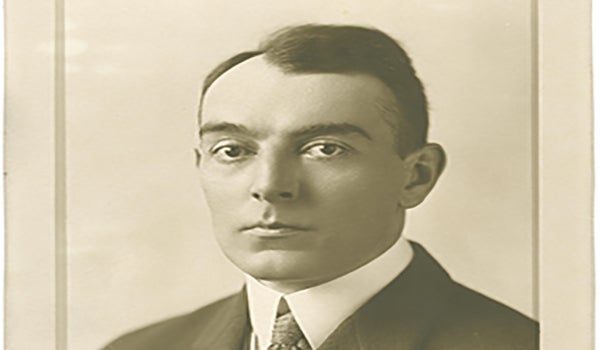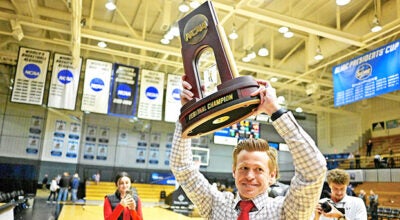A look back at Niles’ most famous journalist
Published 10:12 am Monday, June 18, 2018

- Ring Lardner, who grew up in Niles, went on to become one of the most influential writers in America. (Submitted photo)
Just off of Bond Street in Niles, there is an old mansion that sits on top of the St. Joseph River bluff. A man who grew up there was the boyhood idol of Ernest Hemingway, immortalized in The Catcher in the Rye and integral in revealing one of the largest scandals in sports history — the Chicago “Black Sox.”
Despite these exploits, many people from his hometown still do not know much about him — even if they went to the middle school named after him.
In past years, Ring Lardner Middle School in Niles showcased memorabilia to commemorate its namesake.
The glass case near the school’s entryway was filled with photos depicting the Ring Lardner and gives the students a glimpse into the life of a man that many historians describe as one of the most influential American writers, journalists and humorists in history.
“That’s unique for a town to have a true legacy,” said Keith Clark, a Niles resident who is the editorial director of a media company based in the Boston area.
The students may know his name, but few are aware of just how important of a literary figure he was, and his life doesn’t seem all that interesting to them.
“I don’t have a lot of middle school kids coming up to me and saying ‘tell me more about Ring Lardner!’” said Doug Langmeyer, Ring Lardner Middle School’s former principal, who retired after the 2016-17 school year.
Another reason for this is, aside from the showcase, there is not much commemorating Lardner at the school.
“I never really thought about there not being some kind of plaque dedicating the building to him,” Langmeyer said. “It probably is overdue. It’s probably something that should be done.“
Lardner is often overlooked throughout history. One of the few places where he is recognized is at the Niles History Center, where there are many displays dedicated to his family and his accomplishments.
In the upstairs of the museum, next to the banister, is a glass case containing music lyrics he composed, articles he wrote and his most famous published work: a collection of fictional columns titled “You Know Me Al,” published in 1916.
“I think it just seemed like his work didn’t transcend to other generations,” said Mollie Watson, the assistant director of the history center. “His vernacular is very particular and very of the time, which is what made him so popular in that period. … We know he was friends with F. Scott Fitzgerald, who everybody knows today still and his works are classics. Lardner’s works were so particular that his work didn’t evolve with newer generations.”
She says it could also be the fact that Lardner “never published the great American novel,” whereas Fitzgerald’s “The Great Gatsby” is still consumed by many to this day.
The famed British writer Virginia Woolf also cherished Lardner’s work, and once said he wrote the best prose in America after she read “You Know Me Al.” Woolf agreed with Watson’s assertion that his vernacular was conditioned by the times, saying that the language used in it “is not English.”
Upstairs at the Niles History Center’s Fort St. Joseph Museum is a case that protects the bed Lardner was likely born in, as well as a few books written by his mother.
“We know his mom was a poet,” Watson said. “She actually has a book in this case. She was also an author. … She did a lot of poetry and other things as well.”
Watson and several scholars attribute Lardner’s interests in both music and writing to his mother, who homeschooled her children until they were adolescents.
He attended Niles High School, where he played baseball and football. After he graduated in 1901, his father sent him to Armour Institute in Chicago to study mechanical engineering, but he quickly flamed out. He returned home and started working for the Niles Gas Co. as a bookkeeper, while his older brother, Rex, got a job with the Niles Daily Sun and did correspondent work for the Kalamazoo Gazette and the South Bend Tribune.
Several months later, the editor of the South Bend Times, a newspaper that closed decades ago, came looking for Rex but found Ring, which presented him with his first big break. According to Ring’s own words, which can be found his “Ring: A Biography of Ring Lardner” by Jonathan Yardley, the conversation went something like this:
“‘Oh,” I said, ‘I thought I might tackle the job myself.’
‘Have you ever done any newspaper work?’ [the editor said].
‘Yes, indeed,’ I said. ‘I often help my brother.’
This was very far from the truth.”
His bold-faced lie got him the start he needed, and by 1907 he was working for the Inter-Ocean newspaper in Chicago covering baseball. From there, he worked his way up to the Chicago Tribune.
Throughout the rest of his career, Lardner worked for a number of different news outlets in cities located throughout the Midwest and East Coast, including Boston and St. Louis. He also worked on the elaborate theatrical productions in New York: the Ziegfeld Follies.
For as accomplished and expansive as Lardner’s career was, he was not without faults. Most notably, he held many of the racial overtones that men of his day and affluence often possessed, according to Yardley.
“He was incapable of unkindness to an individual human being, and it did not make the slightest difference what that person’s wealth, social standing, color or religion,” Yardley wrote. “When he lived in Great Neck, he shocked an alienated some of his neighbors by having [black people] as guests in his house […] Yet he could as callous toward the mass of ‘colored’ people as he could be sensitive to an individual black man. He employed, quite casually, almost all of the racial and ethnic slurs of the time.”
Though these views are said to be quite common at the time, they still disappoint historians like Watson when she discusses this loathsome trait.
Nevertheless, he was so popular as a sports writer that when a young Ernest Hemingway wrote for his school newspaper he used the pseudonym “Ring Lardner, Jr.” — not to be confused with Ring’s actual son, Ring Lardner Jr.
Later in life, Ring Lardner Sr. wrote several short stories, which is why he is mentioned as the presumed favorite author of protagonist Holden Caulfield in chapter 3 of J.D. Salinger’s “The Catcher in the Rye.”
Perhaps where he is immortalized most is in the 1988 film “Eight Men Out.” Based on the non-fiction book by the same name, the film depicts the Chicago “Black Sox”: a collection of players on the 1919 White Sox that threw the World Series in exchange for financial compensation. Lardner is played by the film’s director, John Sayles. The character, who is covering the team, is suspicious of the players throughout the movie.
On Sept. 25, 1933, Lardner died of Tuberculosis at the age of 48. The next day, his obituary appeared in the New York Times.
“In a moment of whimsical autobiography some years back Ring Lardner explained that at various times in his life he had cherished three great ambitions,” reads his obituary. “As a youth, he wondered whether he would ever see enough baseball. Then, a little later and in a new period, he wanted to write stories for the magazines–and have them printed. Finally, in a more recent phase, he worried about whether he would ever have a play produced. He was successful in each of the three.”
Lardner’s accomplishments and perseverance are the reason why Keith Clark, of Niles, made sure that, when his own children attended Ring Lardner Middle School, he took it as an opportunity to teach them about the life of Lardner.
“The same people from this town,” Clark said, “who had the same or fewer advantages than you, went out and did amazing things.”






